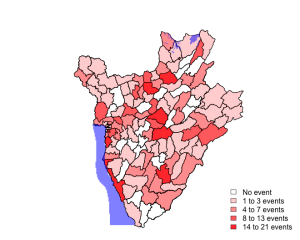Although the 2010 elections cannot be compared to what has been happening in Burundi since Nkurunziza announced his candidacy for a third term (good summary of recent events), the 2010 elections were also perturbed by political violence and intimidations. In a recent paper, Andrea Colombo, Olivier Sterck and I analyze the drivers of electoral violence recorded by Ushahidi during the 2010 electoral period. Based on a similar mock-up, a crowdmap of Bujumbura currently lists documented reports, maps them and coordinates protests.
Three highlights are worth making, and might help the understanding of today's situation.
(1) As IRINnews points out in a recent update: "Recent years have delivered significant reconciliation and Burundi’s political fault lines are less defined in Hutu-Tutsi terms than they used to be, with the fulcrum of tension being whether Nkurunziza should be allowed to run again." Along these lines, our study shows no significant correlation between municipality's ethnic diversity and political violence.
(2) The degree of competition between Hutu demobilized rebels from different groups increased electoral violence. Thanks to the registers kindly provided by the demobilization commission in Burundi, we computed an index of polarization (as a way of measuring competition) between different factions of ex-rebels. The local distribution of Hutu demobilized soldiers, based on their affiliation during the civil war, was one of the main determinant of violence: the more a municipality was polarised (through the presence of two opposing groups of ex-combatants), the more incidents of electoral violence occurred.
(3) Records of electoral violence were higher in municipalities hosting numerous ex-rebels combined with fierce political competition (on the basis of 2005 and 2010 municipal election results). As suggested in the literature, political competition alone is not sufficient to drive violence. The presence of local perpetrators is necessary. Demobilized rebels, whose factions often became political parties after civil war, are good candidates for such a role during electoral campaigns. As such, they might be more likely to resort to violence and rely on non-democratic persuasion tools. The ruling party’s youth wing, the Imbonerakure, consist partly of demobilized combatants. They have been active mostly in rural areas, from which more than 10,000 fled to neighboring Rwanda, and claimed to have been threatened.
Importantly, to summarize an Op-Ed in the New-York Times, history has shown that instability in one country of the Great Lakes region may destabilize the whole area. In particular, "should Burundi erupt into full-scale war, chances are high that Rwanda would intervene - particularly if the response from the international community is muted. That could mobilize anti-Rwanda elements in the region, including the Congo-based Democratic Forces for the Liberation of Rwanda, a militia formed by perpetrators of the Rwandan genocide that is believed to maintain links with some Imbonerakure members. Eventually, other regional forces could be dragged into a conflict."

